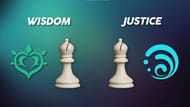On the surface, Genshin Impact looks like a game with a linear storyline that focuses more on “grind-heavy” gameplay than creating a narrative that represents deep characters and lore that hits harder with every chapter.
However, once players start to get more involved with the story, and the world of Teyvat, they soon begin to realize just how expansive and mysterious the world of Genshin Impact really is.
miHoYo has done an incredible job in narrating the story in such a way that even after a year of the game’s release. With the new 2.1 patch on the horizon, the community has more questions than answers regarding the lore.
Looking for Crossword hints & solutions? Check out latest NYT Mini Crossword Answers, LA Times Crossword Answers, and Atlantic Crossword Answers
One common topic of argument among players is the concept of the Gnosis and its relation with its corresponding Archon. While there is a general theory among the community as to some of the Gnosis’ workings, its very nature and importance concerning the world order are still unknown.
Today’s article will try and tackle the broad subject of the Genshin Impact Gnosis and how the philosophy of Gnosticism might have played a role in influencing miHoYo to create a world like Teyvat.
What is Gnosis in Genshin Impact?

Players who have been attentive towards the Genshin Impact storyline so far will recognize the Gnosis as an item that resides in the body of an Archon, one of the seven territorial gods, who uses it to tap into the energy of the Celestia.
The Celestia is a mysterious place, a land floating above Teyvat that allows mortals who have performed heroic deeds to ascend to godhood.
So how does this exactly tie in with the Gnosis?
It’s vital to note that during the closing chapters of the Genshin Impact prologue in Mondstadt, Venti, after losing his Gnosis to Signora, explains to the Traveler the difference between an “Archon with Gnosis” and a “Mortal with Vision.”
Vision allows a human being to channel a particular element, and a mortal in possession of one is called an “allogene.” The current Seven were all once mortals and ascended to god through some heroic deed, or defeating and replacing a previous Archon.

In light of this information, fans can reasonably consider that a Gnosis in Genshin Impact does not simply provide an Archon with “a foci” to channel the element, as they previously had the Vision for it. But instead, the Gnosis strengthens that very power and perhaps grants the corresponding Archon a firm “Ideal.”
For those who haven’t noticed, the Seven are very territorial, ruling their kingdoms with a particular “Ideal.” While Venti/Barbatos rules over Mondstadt with the principle of freedom, Morax/Zhongli was a bit more restrictive about the founding principles of Liyue and anthropomorphized the “Ideal of contracts.”
Similarly, each Archon has a divine “Ideal” unique to them, and it’s a common theory that it is the Gnosis that either aids or determines that.

So, a Gnosis is something either given to an “allogene” who ascends to become an Archon via heroic deeds or is taken from a previous god by defeating them, as the original Seven did. This raises the possibility of the existence of a being even more potent than the Archons, one presiding over all of them
Community theories suggest that this “supreme being” resides in Celestia and is the God who supposedly looks over Teyvat. And it is this being that the leader of Genshin Impact’s Fatui, The Tsaritsa, is trying to rebel against and overthrow.
Gnosticism and the “False God”

Now with the basic explanation of Gnosis done with, let’s get into a bit of theory crafting that some members of the Genshin Impact community have come up with.
Many fans parallel the Teyvat world creation to the philosophy of Gnosticism and feel that what is apparently noticeable in the game is not the actual state of the world.
YouTuber DaikenXDan in his “THE TRUTH BEHIND THE ARCHON GNOSIS” video, draws an interesting theory on how the supreme being in Celestia, who presides over the Seven, is not the true God of Teyvat, but rather a False God, a “half maker.”
The YouTuber believes that the very concept of Genshin Impact’s Gnosis is derived from the philosophy of Gnosticism, which claims that humans contain a part of the true God, known as the “divine spark.” However, humans cannot achieve divinity via the mortal realm as their body is created by an inferior being, considered evil.

And it is this being whom humans consider the true God. But according to the Gnostics, this is not the case. The true spiritual being is the one who is still unknown as it was the lesser being who made the world in his inferior image.
DaikenXDan further explains that the hint to Gnosticism resides in Genshin Impact’s very name itself. The Chinese name for Genshin Impact is Yuánshén, which roughly translates to “Primordial Spirit” or the “Fundamental Essence of Life.”
Keeping this in mind, the content creator suggests that it won’t be surprising if Gnosticism had a significant influence on Genshin Impact’s world design. And that the God above the Archons is not the actual supreme being of Teyvat.

It is one of the reasons why The Tsaritsa is trying to rebel against Celestia and why Venti did not mind after his Gnosis was pulled from him, while Zhongli freely gave his up.
Perhaps, some members of the Seven realize that the “being” above them is not the real God, which is why the world order needs to change.
Genshin Impact, chess, and “No Game No Life”

The Gnosis for each Archon represents a particular chess piece. The one from Venti/Barbatos is the Queen piece representing the “Ideal” of freedom that the Mondstadt Archon represents. As the Queen has the freedom to move in whichever direction that she wants.
The piece for Morax/Zhongli is that of the Rook, which signifies a single-track mind, and with the divine “Ideal” of contract, Liyue and its residents are some of the most straightforward individuals in Teyvat.
YouTuber IslandXD in his “Gnosis Hidden Identities” video cites a theory on how chess and the pieces in it have a big role to play in Genshin Impact’s storyline.
Much like with the Japanese visual novel No Game No Life, which, too, attributes a God with a chess piece, the YouTuber believes that the very nature of a particular piece has a lot to do with the current Teyvat lore.

He attributes the “Ideal” of Wisdom and Justice with the Bishop pieces, while Baal and Murata are the Knight pieces.

He feels that the False God in Celestia is the King piece, as the being is not known to move out and come to the mortal world.
The Rook, the Castling, and the Tsaritsa

Taking the theory a bit further, IslandXD theorizes that the Fatui leader, The Tsaritsa, will probably boast the chess piece of the Rook, and he cites a few reasons to back the argument up.
IslandXD feels that as the Rook signifies the “chariot” in Chinese chess, the mere fact that Zhongli/Morax leads the Adepti and the Tsaritsa leads the Fatui hints at the notion that their Gnosis will represent the same chess piece. The chariot horses personify the members who work for them, in this case, the Adepti and the Fatui Harbingers.

However, it is not the only reason why IslandXD attributes the Rook piece to the leader of the Fatui. The Rook has a special attribute with the King piece in chess, where they can change positions, and that is the only time that the King moves more than one square in the game.
IslandXD feels that if the Tsaritsa has a Rook Gnosis, then her act of rebellion against the Celestia in Genshin Impact might be to change the place of the King in the board, which in this case would be to bring the False God to the mortal plane.

One rule of castling is that there should not be any pieces blocking the way between the Rook and the King. And to parallel it with the Fatui’s modus operandi of aggressively seeking all the Gnosis of the six Archons goes to show that the Tsaritsa does not want anyone between her and the False God.
The Pawn and the True God of Liyue

Depending on how a chess player uses it, the Pawn can either be incredibly useful or utterly useless in a game.
So the theory that IslandXD and many community members propose is that perhaps the Traveler represents the Pawn piece in Genshin Impact. What provides more weight to this theory is that the Pawn can turn itself to any piece of its choice, except the King, when it reaches the enemy’s starting squares, and this unique ability is called “Promotion.”
The Traveller being able to use all the elements plays in perfectly with the concept of the Pawn, as the protagonist is capable of promoting their vision to take in any of the seven elements in Teyvat.
At this point, players might wonder that there are eight pawns in chess, but there are only seven elements in the game, so what happens to the extra pawn piece if the rest seven signify the Traveler?

IslandXD theorizes that the extra chess piece is perhaps the twin sibling the player does not choose as their protagonist and gets separated from.
The very nature of the Pawn piece has led many in the Genshin Impact community to feel that perhaps the Traveler is or is destined to be the true spiritual being of Teyvat. And the quest to reunite with the twin is ultimately going to be the quest to overthrow the False God.
The Fatui of Snezhnaya is perhaps not wrong in wanting to change the world order, which is surviving on a false pretense.
miHoYo and their incredible lore crafting
When it comes to the narrative and story expositions, miYoHo has done an incredible job crafting an intricate world design for Genshin Impact.
While a large part of the story is yet to be explored, as the narrative has only just reached the Inazuma arc, gamers are having a great time exploring Teyvat and finding clues in various locations to piece together their own theories about the world order.
With Genshin Impact patch 2.1 on the horizon, the community is quite excited to see just how the story will progress in miHoYo’s flagship title.
Are you stuck on today's Wordle? Our Wordle Solver will help you find the answer.
